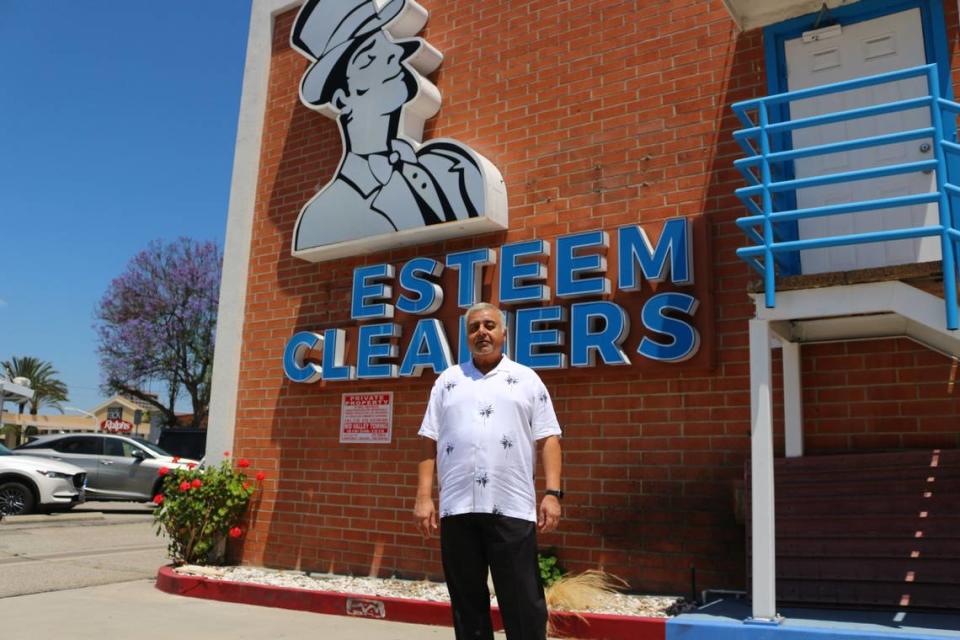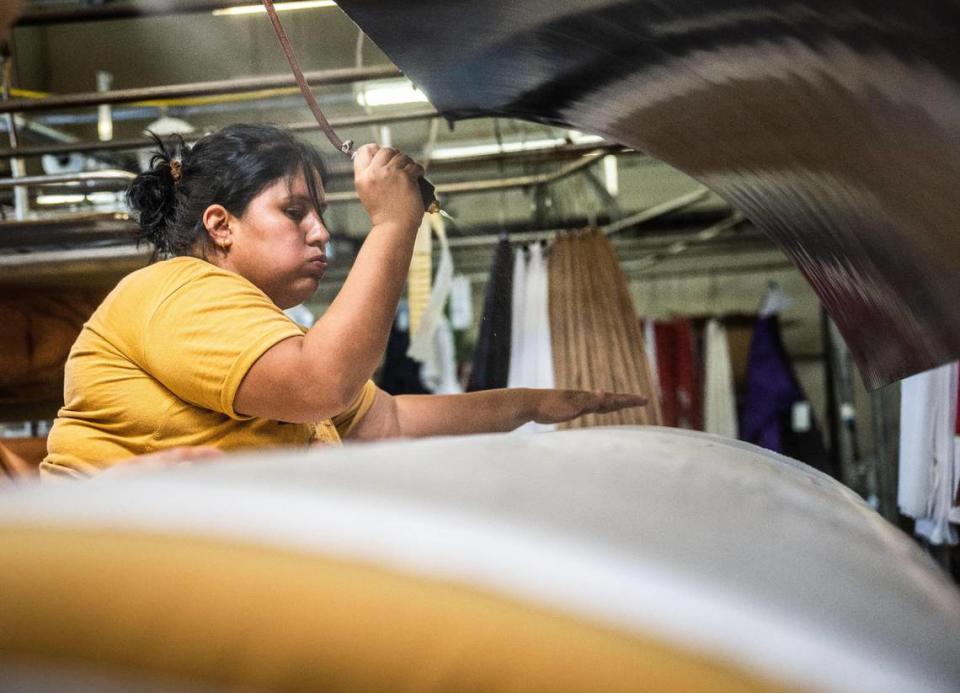Exclusive: California’s small dry cleaners face massive bills to clean up toxic chemical
Editor’s note: This is the second in a three-part series on the environmental and public health threat posed by decades of pollution from dry cleaning chemicals across California.
Taline Mazlemian will never forget the day her uncle died nearly 20 years ago.
“Thursday, April 15, 2004, my uncle called me — it was maybe 1 or 2 o’clock and he says, ‘I’m not feeling so great, you think you can come and close the shop for me?’”
Mazlemian showed up at the store, Paragon Cleaners and Laundry near Hollywood, and promised her uncle she could handle the shop for the day.
“That was the last time I ever saw him again, he died in his sleep, he was 54 years old,” she said of her uncle, who died of a massive heart attack. “He died early in the morning, like maybe 5 o’clock, 6 o’clock. By 9:30, I was here (at Paragon Cleaners). And I never left.”

Over the past two decades, Mazlemian has worked every day at the dry cleaners.
It’s been a family business since the day her dad bought it in 1973 — about a decade after he immigrated to the United States from communist-ruled Bulgaria.
Just about a year after her uncle died, Mazlemian went to the bank to get a loan for the shop. Because it was a dry cleaning business, the bank required her to hire a contractor to investigate whether the property had any environmental issues due to the use of perchloroethylene, a popular yet toxic dry cleaning chemical known as PCE.
That investigation kickstarted a multi-decade effort to identify a plume of PCE-contaminated soil and groundwater that had spread from under Paragon Cleaners toward nearby properties such as the Academy of Motion Picture Arts and Sciences, various restaurants and homes.
Concentrations of PCE in the groundwater under the cleaners were found up to 2,600 micrograms per liter, more than 500 times the U.S. Environmental Protection Agency’s safe limits of 5 micrograms per liter.
It has cost Mazlemian millions of dollars to fund the various soil and groundwater sampling, oversight costs from the State Water Resources Control Board, and remediation efforts of the contaminated soil. It is revenue she can’t afford to spend on the PCE cleanup, especially since the COVID-19 pandemic resulted in a 75% loss of business for Paragon Cleaners, Mazlemian said.
The American dream her father wanted was now a nightmare she hasn’t awoken from.
“They literally gave us permits to operate perchloroethylene (PCE),” Mazlemian said of the permits granted to Paragon Cleaners from the state to use the dry cleaning chemical. “Why would you allow a business to use something and then penalize them for it? And they knew the dangers (of PCE) long before they made us stop using it.”
The plight of Paragon Cleaners is not unusual in the industry.
Dry cleaning businesses across California are in similar straits, with as many as 7,500 locations identified as potentially needing cleanup from PCE pollution.
Dry cleaners were permitted to use PCE for decades
After operating with permits allowing PCE since at least the 1940s, dry cleaners in California have been forced to transition away from the chemical their machines were designed to use.
If exposed to PCE, humans have a greater chance of developing certain cancers, kidney disease, liver disease, reproductive and birth defects, neurotoxicity and other adverse health impacts, according to numerous scientific studies.
As of Jan. 1, the state requires dry cleaners to use chemicals considered to be environmentally safe or do wet cleaning with detergents.
But banning PCE doesn’t wipe away the pollution left throughout the state as a result of decades-long use of the cleaning solvent.
Dry cleaning is an industry with little formal training, meaning there are no certifications or degrees required to open a business. So, operators didn’t necessarily know that dumping used PCE down the drain would cause an environmental catastrophe.
Although the state supported dry cleaners in the transition away from PCE through grants to buy new cleaning machines and by offering training on how to safely use other cleaning solvents or do wet cleaning with detergents, many cleaners feel they’ve been left out to dry when it comes to cleaning up the pollution often found under their businesses and neighbor’s water supplies.
“All these years, money literally went in a hole in the ground,” said Ray Rangwala, owner of Esteem Cleaners in Pasadena and a member of the Southern California Cleaners Association. “There’s really not much to show for it, other than my bank balance is way less than what it should be. I had to sell all my retirement money (liquidate his investments). I don’t have any savings left.”
Rangwala spent 16 years working to remediate PCE pollution from his business.

The cleanup was done through a series of wells dug to extract the dirty gas in the soil and put it through filters to remove the toxic PCE. To do the work, Rangwala paid at least $95,000 of his own money before $800,000 worth of state grant money kicked in to help finance the rest.
Rangwala’s business sits in an area just outside of Los Angeles where housing is in a perpetual deficit.
But cleaning up the PCE pollution from underneath the property to be safe enough for residential development has proven to be too expensive for Rangwala and the landlord.
“If I spent another $2 million or $5 million, it would fix the problem,” Rangwala said. “So nobody’s even going forward with that because none of us has enough money to do it.”
The $800,000 Rangwala received from the state came from the State Water Resources Control Board’s Site Cleanup Subaccount Program, otherwise known as SCAP.
The program was established in 2014 and appropriated $34 million annually through 2025.

SCAP has been the main funding source for cleaning up dry cleaner pollution in California. The program was designed to help fund various types of groundwater cleanups — including those from gas stations and car mechanic shops.
The Department of Toxic Substances Control was allocated $152 million to investigate dry cleaners in disadvantaged communities for PCE contamination. The department also often has grants available for dry cleaners to investigate and remediate PCE pollution left under their businesses.
But it’s not enough.
State funding doesn’t come close to covering cleanup costs
The sheer number of dry cleaners in California that have inadvertently created plumes of pollution means not everyone gets grant money to fund cleanups.
A PCE cleanup typically costs about $1 million to more than $10 million.
The high costs come from the extensive mapping of groundwater and soil samples required to determine the extent of a PCE plume — which can flow for several miles in groundwater under cities — and the regular monitoring of how effective the remediation efforts are.
Remediation typically involves pumping up polluted groundwater, ridding it of chemicals and then releasing it back into the ground. Or, engineers will install machines in the ground that essentially suck the PCE-contaminated air from the soil, feed it through filters and release it into the environment.
The remediation work can take several years, if not decades, to bring the groundwater and soil to healthy levels that meet state standards.
During that time, a dry cleaner must pay for the environmental consultants who conduct the remediation and monitoring work, as well as the oversight costs of DTSC or water board officials monitoring the efforts.
The typical rate for water board oversight is about $215 per hour.
The Los Angeles Regional Water Quality Control Board has estimated it will charge Mazlemian $25,800 for the 2023-24 fiscal year, according to a letter from the water board to Mazlemian.
Mazlemian hasn’t been able to get funding from the state to help cover the money she’s spent on the cleanup, and has had to get creative.
“It has been more than we could ever afford,” she said. “But we didn’t have any other option — we have to clean it up.”
Luckily for Mazlemian, she’s been able to stay afloat to serve her niche clientele of local and traveling performers with sweaty costumes.
That isn’t the case for everyone, dry cleaners remain a struggling industry.
An estimated 33% have closed their doors across the state since 2020, following nationwide trends, according to the California Cleaners Association.
“Back in the ’90s, it was a lot easier to find the dry cleaner operators because most of them were still operating,” said Peter Krasnoff, an engineer for San Francisco Bay-based West Environmental who has worked on hundreds of dry cleaner remediations.
Now, in many cases, old dry cleaner buildings sit vacant and abandoned. Others are now home to businesses such as restaurants, clothing stores and barber shops which are still being held accountable for any PCE pollution found leftover from the dry cleaners.
The dry cleaners that remain in business are hamstrung by environmental cleanup costs, pitfalls from the COVID-19 pandemic and rising labor costs.
Many have had to astronomically increase the cost of their services in attempts to stay afloat, making dry cleaning a luxury rather than a blue-collar necessity.
“The American dream as you get older is that you can retire into the sunset and not work,” Rangwala said. “It’s not that anymore.”
Behind the story
This series was produced as a project for the USC Annenberg Center for Health Journalism’s 2023 California Health Equity Fellowship.
Mackenzie began investigating the issue of dry cleaner pollution in California in March after she reported on perchloroethylene (PCE) contaminated groundwater in San Luis Obispo for The Tribune.
During the six months following, Mackenzie filed public records requests with the state to receive data on the number of dry cleaners in California to gain perspective on the problem. She soon learned there were at least 7,500 dry cleaner sites in the state, an estimated 75% of which had created plumes of PCE pollution.
Mackenzie then spent months traveling across the state — to Los Angeles, Sacramento and Lake Tahoe — to speak with dry cleaner business owners, health experts and environmental engineers and consultants.
She also spoke to experts from California and other states who were tasked with investigating and cleaning up the pollution leftover by the dry cleaners.
Through interviews with her sources, Mackenzie learned of the ubiquitous nature of PCE pollution in California. Sources from state agencies also revealed how they felt unequipped to deal with the PCE pollution issue and told her they hope her stories bring attention to the dangerous chemical leaking beneath many cities and towns in the state.
Acknowledgements
Joe Tarica | Editor
Hector Amezcua | Photography and video
Sohail Al-Jamea | Video editing
Rachel Handley | Illustration
Gabby McCall | Logo design
Susan Merriam | Data visualization and development

